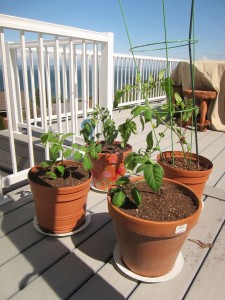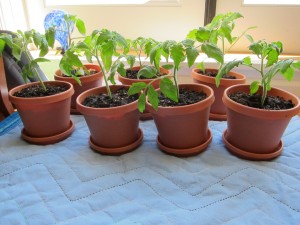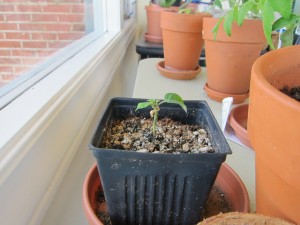
Here in the Pacific Northwest, tomatoes are a challenge to grow. The Holy Grail, my hairdresser advises me. Kimberly has had a knack for accuracy in the year or so since I met her at an olive oil tasting, so when she says something, I believe her.
Of course, I also like a challenge. Back in the day, I was one of those women who sought out men who were just that, and the more emotionally unavailable they were, the better. If life gets too easy, I get nervous. A long time ago I learned to break off those relationships in favor of healthier ones, but apparently I still need to beat my head against the wall now and then…so why not grow something that some people say I can’t?
The problem here (with tomatoes, not men) is a lack of heat. We have to coax, cajole, and sometimes trick the plants in order to get fruit from them. Summer disappears at times before it arrives, keeping the fruit from turning red. While I don’t mind the occasional fried green tomato, I like mine fully ripened, thank you.
This year I grew them from seed, which helped me get through the dark, moody winter days. As the seedlings started to sprout and grow, I learned how to “pot up” the plants before setting them outside. That means I keep putting the plants in larger and deeper pots as they grow. I set them deep into the new pots and trim off the bottom leaves, burying most of the stem. This allows them to form long, substantial root systems.
Setting down roots is not my forte. Growing up, our family moved around from town to town due to job changes and transfers. Even in Houston, where I lived for 30 years, I found myself repeating the pattern, moving into new neighborhoods and apartments when changing jobs. I lived in one house for nearly ten years, but other than that, I’ve lived the life of the proverbial rolling stone. When hubby and I settled down and married, we satisfied our restless spirits and itchy feet through travel. Now that we live in the type of place we always wanted to travel to, we travel less. It’s good for the garden for me to be home, but at times I still yearn for the vagabond life.
When I arrived in Port Townsend a year ago, I planted the seed of myself here. Like a good tomato plant, I grew toward the light and started the process of growing my roots. I didn’t grow into my new home as soon as I expected…but little by little, I am getting to know people and am finding my way.
On a daily basis, I’m consulting gardening books and online resources. These tomato plants, grown from seed, are my precious children. Some of them have died along the way, and I have grieved every loss. Still, I now have so many thriving plants that I’m not sure where I’m going to put them all. As I’ve gotten to know some people better, I’ve learned that not every seed of friendship will grow, either. Some will thrive, some will not. Some will grow slower than others.

It’s too soon to tell if my efforts in tomato growing will pay off. Next week I’m going to a class taught by a local expert, but unpredictable weather wreaks havoc here, as it does with any garden anywhere. It’s possible that I will go to all this trouble and not get a single tomato. Still, I’ve increased the odds, and my life is better for having taken the chance. Planting a garden means I’m willing to take a risk. Moving cross-country means taking a risk with new people, new situations, new culture.
As I help my tomatoes build their root system, I am also building my own. It takes time, patience, and some finesse. I will do my best to create sturdy plants, and in doing so, increase my own sturdiness.

Ah, Nadine. I seem to have missed that you’ve been blogging again. Good luck with the tomatoes. Do you have any corner of your property where you could create a proper tomato micro-climate? For example, since St. Louis is a city of brick houses, things planted next to the house bloom really well because the brick retains the heat. Or maybe you just need to hook up an outside grow lamp.
Hey, Julie! Yes, the tomatoes are going on a deck that has good south-facing exposure. We can also use dark plastic and other little tricks for keeping the soil warm. I’m looking forward to the class next week, as I’m sure I’ll learn more! I’ve seen this guy’s tomato plants, and they’re incredible. He is dedicated to researching and teaching others how to grow heat-loving vegetables, including peppers and eggplant (I’m not trying either of those this year — maybe next year).
I hope your tomato plants do well, but even if they don’t, it’s obvious that you are enjoying the journey! You have the true faith of the gardener or farmer: plant the seed and do your best to help it grow. That’s really all you can do because so much is out of our hands. What a wonderful lesson that is for lots about life! I enjoy reading about your gardening journey, and I love the connections you make to the rest of your life. So many lessons in nature, if we only look!
I agree, Tina. Nature is a wondrous teacher, and I am continually humbled by what she teaches me. I didn’t start gardening until I was 51, and I wish I had had more exposure to it sooner. I have a lot of farming in my DNA (my dad lived on a farm, and many of my ancestors before him), and I feel connected to all of life when I’m growing new plants.